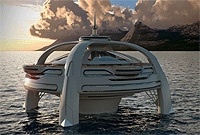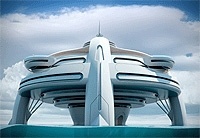In a project named Utopia, BMT Nigel Gee and partners Yacht Island Design have designed what is described as an avant-garde island-like yacht that exploits existing technologies to create a new maritime experience.
What BMT has devised is a piece of floating real estate that measures more than 65m above water with four legs that support a 100 x 100m structure spanning 11 decks. James Roy, yacht design director of BMT Nigel Gee said the gross tonnage (as a measure of volume) is around 100,000GRT.

‘There was an air of excitement among the engineers to have the freedom to create something not boat-like,’ said Roy. ‘We wanted to change the notion of going somewhere with being somewhere.’
Roy told The Engineer that the main global load bearing structure will be steel. Areas that are minor load bearing might be made in aluminium to save weight and local areas with high degrees of compound curvature might be made from Fibre-reinforced plastic (FRP).
Keeping a ship stable is vitally important for passenger safety and comfort. The potential to move in six different ways — heave vertically, sway side to side, surge front/back motion, roll, pitch and yaw — can lead to an uncomfortable trip if the motion isn’t minimised.
Engineers can tackle this in a number of ways such as minimising the hull’s cross-sectional area at the sea’s surface in order to reduce the impact of wave energy.
‘By minimising waterplane area in relation to displacement, heave motion is minimised, as well as lateral and longitudinal stiffness, so sea keeping is improved,’ explained Roy.
Stability is claimed to be inherent in the design and the configuration of the legs means that Utopia should be steady in a storm. The principles, said Roy, are not so different from large offshore structures, such as an oil platform.
‘You would need to use precise dynamical positioning, but that technology is already widely used in offshore drilling,’ commented Dr David Andrews, professor of Engineering Design at University College London. ‘So it doesn’t sound unreasonable and should be technically feasible.’

Each leg employs azimuth thrusters to maintain the station keeping of the so-called ‘island’. This system, which uses a propeller encased in a pod that can be rotated, provides greater manoeuvrability than traditional fixed propeller-rudder systems, and should allow Utopia to smoothly redeploy to any desired location at a speed of about seven knots, said Roy.
‘Circular designs, however, don’t move efficiently — it will need a lot of tugs,’ added Andrews.
The exact nature of power generation is still under consideration but Roy explained: ‘Perhaps a mix of solar, tidal — using the thrusters as turbines to generate power from currents when moored — and wind. However the mix is likely to be quite heavily skewed towards fossil based fuels.’
The concept design for BMT’s moveable super-island was unveiled at the Monaco Yacht Show in September.
‘We had lots of interest and we have a number of leads to follow,’ said Roy. ‘Ultimately this would be a very high-value project requiring a massive capital investment, but we are optimistic.’





Nanogenerator consumes CO2 to generate electricity
Whoopee, they've solved how to keep a light on but not a lot else.